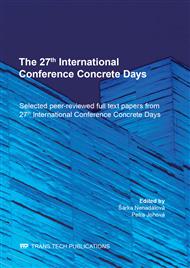p.1
p.11
p.17
p.23
p.35
p.45
p.53
Simplified Analytical Determination of Bending Moments in a Two-Way Slab Using a Web-Based Application
Abstract:
In the last decade, the computing power of computers has significantly increased, which enabled very detailed and accurate numerical static non-linear analyses of reinforced concrete structures to be carried out using sophisticated commercial software. However, higher risk of errors, both in the calculation inputs and algorithm, is linked with the increased detail and accuracy of numerical modelling. For this reason, it is convenient to verify the results provided by sophisticated software using simplified analytical approaches. In order to provide a tool for quick and easy verification of results provided by sophisticated software, a novel web-based application employing simplified analytical methods has been developed by the authors of this paper. This web-based application is capable of quick and easy calculations of bending moments in reinforced concrete two-way slabs. For the calculation of bending moments, the Marcus Method is employed. This method introduces a correction coefficient to the Rankine-Grashoff Theory of Equal Deflections in order to account for the torsional restraints at the corners of the slab. These analytical methods are algorithmized and implemented using the JavaScript programming language. A graphical user interface for the input of data and for the interpretation of results is created using the HTML markup language. The novel web-based application is freely available and works on all common devices and operating systems. From the presented results, it is clear that the novel web-based application is quick, easily available, user-friendly, and intuitive. The web-based application can be used for the verification of the calculated bending moments during the design of a reinforced concrete two-way slab.
Info:
Periodical:
Pages:
45-52
Citation:
Online since:
July 2021
Authors:
Keywords:
Price:
Сopyright:
© 2021 Trans Tech Publications Ltd. All Rights Reserved
Share:
Citation:


